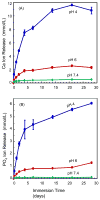Calcium and phosphate ion releasing composite: effect of pH on release and mechanical properties
- PMID: 19101026
- PMCID: PMC2649691
- DOI: 10.1016/j.dental.2008.10.009
Calcium and phosphate ion releasing composite: effect of pH on release and mechanical properties
Abstract
Objectives: Secondary caries and restoration fracture are the two main challenges facing tooth cavity restorations. The objective of this study was to develop a composite using tetracalcium phosphate (TTCP) fillers and whiskers to be stress-bearing, and to be "smart" to increase the calcium (Ca) and phosphate (PO(4)) ion release at cariogenic pH.
Methods: TTCP was ball-milled to obtain four different particle sizes: 16.2, 2.4, 1.3, and 0.97 microm. Whiskers fused with nano-sized silica were combined with TTCP as fillers in a resin. Filler level mass fractions varied from 0 to 75%. Ca and PO(4) ion releases were measured vs. time at pH of 7.4, 6, and 4. Composite mechanical properties were measured via three-point flexure before and after immersion in solutions at the three pH.
Results: TTCP composite without whiskers had flexural strength similar to a resin-modified glass ionomer (Vitremer) and previous Ca-PO(4) composites. With whiskers, the TTCP composite had a flexural strength (mean+/-S.D.; n=5) of (116+/-9)MPa, similar to (112+/-14)MPa of a stress-bearing, non-releasing hybrid composite (TPH) (p>0.1). The Ca release was (1.22+/-0.16)mmol/L at pH of 4, higher than (0.54+/-0.09) at pH of 6, and (0.22+/-0.06) at pH of 7.4 (p<0.05). PO(4) release was also dramatically increased at acidic pH. After immersion, the TTCP-whisker composite matched the strength of TPH at all three pH (p>0.1); both TTCP-whisker composite and TPH had strengths about threefold that of a releasing control.
Significance: The new TTCP-whisker composite was "smart" and increased the Ca and PO(4) release dramatically when the pH was reduced from neutral to a cariogenic pH of 4, when these ions are most needed to inhibit caries. Its strength was two- to threefold higher than previously known Ca-PO(4) composites and resin-modified glass ionomer. This composite may have the potential to provide the necessary combination of load-bearing and caries-inhibiting capabilities.
Figures






References
-
- Söderholm KJ, Zigan M, Ragan M, Fischlschweiger W, Bergman M. Hydrolytic degradation of dental composites. J Dent Res. 1984;63:1248–1254. - PubMed
-
- Goldberg AJ, Burstone CJ, Hadjinikolaou I, Jancar J. Screening of matrices and fibers for reinforced thermoplastics intended for dental applications. J Biomed Mater Res. 1994;28:167–173. - PubMed
-
- Ferracane JL, Berge HX, Condon JR. In vitro aging of dental composites in water --Effect of degree of conversion, filler volume, and filler/matrix coupling. J Biomed Mater Res. 1998;42:465–472. - PubMed
-
- Frankenberger R, García-Godoy F, Lohbauer U, Petschelt A, Krämer N. Evaluation of resin composite materials. Part I: In vitro investigation. Am J Dent. 2005;18:23–27. - PubMed
-
- Watts DC, Issa M, Ibrahim A, Wakiaga J, Al-Samadani K, Al-Azraqi M, Silikas N. Edge strength of resin-composite margins. Dent Mater. 2008;24:129–133. - PubMed
Publication types
MeSH terms
Substances
Grants and funding
LinkOut - more resources
Full Text Sources
Other Literature Sources
Medical

